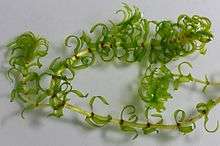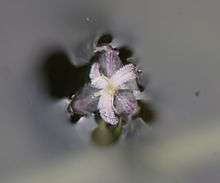Elodea nuttallii
Elodea nuttallii is a species of waterweed known by the common name western waterweed or Nuttall's waterweed.[1] This is a perennial aquatic plant which is native to North America where it grows submersed in lakes, rivers, and other shallow water bodies. It is also found in Eurasia, where it is commonly weedy; it is not known as a weed species in its native range. It is sometimes used as an aquarium plant.
| Elodea nuttallii | |
|---|---|
 | |
| Scientific classification | |
| Kingdom: | Plantae |
| Clade: | Tracheophytes |
| Clade: | Angiosperms |
| Clade: | Monocots |
| Order: | Alismatales |
| Family: | Hydrocharitaceae |
| Genus: | Elodea |
| Species: | E. nuttallii |
| Binomial name | |
| Elodea nuttallii (Planch.) H.St.John | |
| Synonyms | |
|
Anacharis nuttallii | |

Description
It is similar to its relative, Elodea canadensis. However, the leaves taper to an acute point. It has a thin branching stem with whorls of flat leaves at intervals. Some leaves are recurved and twisted, with minute teeth. It bears tiny flowers, the staminate ones abscissing from their stalks and floating away from the plant. It flowers from May until October.[2] In Europe nearly all individuals are female, only some places with male plants are known.[3]
Distribution
This species is native to temperate North America. It has been naturalised in Europe since 1939 and in Japan since the 1960s.[4] The first European record of Elodea nuttallii was probably 1914 in England, though it had been identified wrongly as Hydrilla verticillata,[5] with correct identification as Elodea nuttallii occurring in 1974. It seems to have been originally naturalised in Oxfordshire in 1966, but has now spread to most of England, and many parts of lowland Wales and lowland Scotland. The first record in Ireland was in Lough Neagh in 1984, and it has now spread widely in the country.[4] It is an invasive species in Europe; it reached Belgium in 1939, the Netherlands in 1941, Germany in 1953, Denmark in 1974, Sweden in 1991 and Norway in 2006. It is now present in most of Northern Europe, in many parts displacing the invasive Elodea canadensis.[6]
References
- "BSBI List 2007". Botanical Society of Britain and Ireland. Archived from the original (xls) on 2015-01-25. Retrieved 2014-10-17.
- Rose, Francis (2006). The Wild Flower Key. Frederick Warne & Co. pp. 483–484. ISBN 978-0-7232-5175-0.
- "Unbenanntes Dokument". www.aquatischeneophyten.de. Archived from the original on 2015-08-14. Retrieved 2017-01-31.
- "Elodea nuttallii". Online Atlas of the British and Irish Flora. Retrieved 13 March 2020.
- Bennet 1914, cited in Weber-Oldecop, D.W. (1977): Elodea nuttallii (Planch.) St. John, eine neue limnische Phanerogame der deutschen Flora. Archiv für Hydrobiologie 79: 397-4037
- "Invasive Alien Species Fact Sheet : Elodea canadensis, Elodea nuttallii and Elodea callitrichoides" (PDF). NOBANIS. Retrieved 2020-03-13.